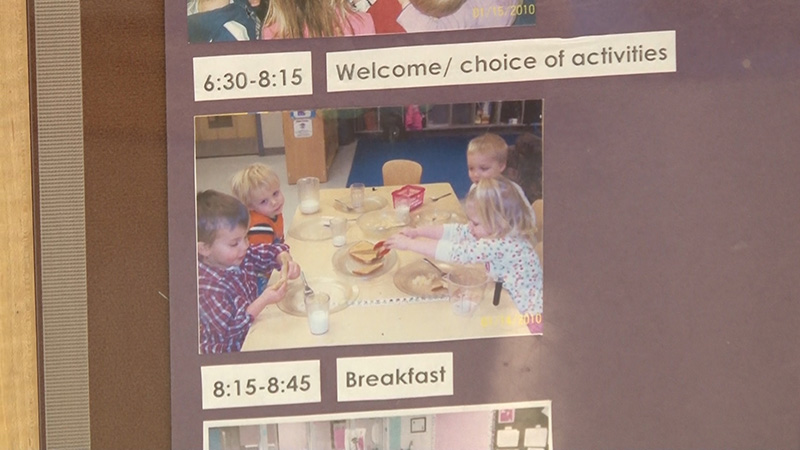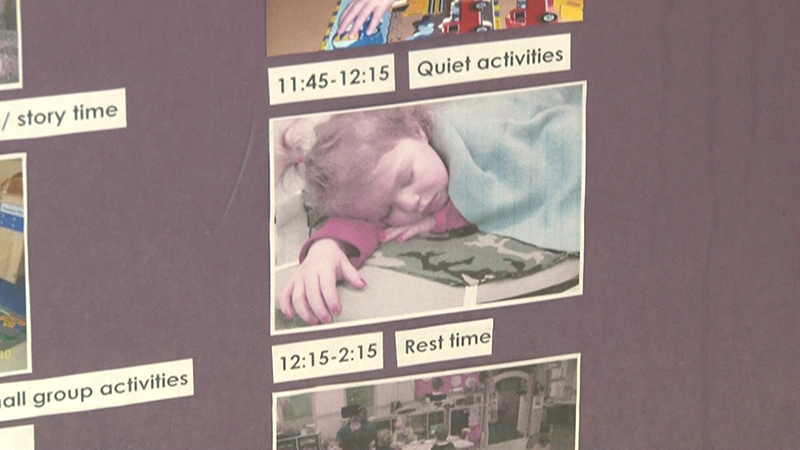本课程描述了您的婴儿和蹒跚学步的早期保健和学习环境如何支持自我调节的发展,并有助于防止具有挑战性的行为。狗万app怎么下载可预测的时间表,响应例程和学习环境的物理设计都影响了积极指导的推广。狗万app怎么下载
Secondary tabs
- 确定环境可以帮助支持自我监管的方式。
- 探讨环境可以提供额外的帮助support and prevent challenging behaviors.
- 学习ways to support infants, toddlers and families through consistent and responsive routines and transitions.
学习
知道
当你想到“环境”这个词时,想到了什么?环境不仅包括物理空间和家具安排,而且包括人的惯例,日程,时间,空间的体验和情感。
幼儿在生命的前五年中为自我监管制定自我监管的基础技能,这意味着护理人员和早期童年教师在帮助幼儿规范他们的思想和行为方面发挥重要作用。作为婴儿和幼儿照顾者,您有机会继续探索环境可以用作支持自我规定的发展的强大工具,以防止具有挑战性的行为。对于那些不能将自己从一个活动移动到另一个活动的年轻婴儿,环境尤为重要。物理环境,小组规模,日程时间表,计划和例程应该鼓励婴儿和幼儿的安全和安全感。
创建支持婴儿和幼儿的环境
 环境是婴儿和蹒跚学步的关键要素。这是成年照顾者,决定婴儿和幼儿看到,触摸和听到什么。他们做出了关于新鲜空气,阳光和运动婴儿和幼儿的决定。成人护理人员创造了物理空间,选择材料和玩具,并提供有助于为婴儿和幼儿制作的互动和体验。婴儿和幼儿依靠成年人创造一个支持关系的环境,鼓励响应成年人的关怀,并适合他们的年龄,发展,利益和文化。
环境是婴儿和蹒跚学步的关键要素。这是成年照顾者,决定婴儿和幼儿看到,触摸和听到什么。他们做出了关于新鲜空气,阳光和运动婴儿和幼儿的决定。成人护理人员创造了物理空间,选择材料和玩具,并提供有助于为婴儿和幼儿制作的互动和体验。婴儿和幼儿依靠成年人创造一个支持关系的环境,鼓励响应成年人的关怀,并适合他们的年龄,发展,利益和文化。
从他们出生的那一刻起,婴儿参加了多个感觉,如灯光,声音,运动,饥饿,疲劳等。幼儿感知和回应感官信息的方式影响他们如何回应他们周围的世界,包括人,包括人们,及其持续发展的自我监管。例如,一个对声音更敏感的幼儿可能很容易被淹没,在早期保管和学习环境中始终播放。狗万app怎么下载护理人员可能会注意到这个幼儿击中同行,遇到目光接触的困难,在噪声水平高于往常时延长一段时间。
As an infant and toddler caregiver, you have the opportunity to stay connected with a young child’s family. Connections with young children’s families help you find ways to support infants’ and toddlers’ unique needs, which helps young children regulate behaviors and feel safe and successful in the care setting. Ongoing observation can also provide clues about how a young child is seeing, making sense of and responding to the environment.
Below are some examples of how the environment can directly impact social development, and strategies to consider within your early-care and learning environment to support self-regulation and prevent challenging behavior:
 响应性,一致的常规和时间表有助于加强婴儿,幼儿和护理人员之间的关系。这提供了安全感和控制感,让婴儿和幼儿知道接下来是什么,这让他们可以放松和探索他们的环境。发达的清晰和一致的时间表和例程可以帮助保持幼儿从事当天的活动,预防痛苦,减少幼儿的焦虑,特别是那些抵抗变革或惊喜的人。
响应性,一致的常规和时间表有助于加强婴儿,幼儿和护理人员之间的关系。这提供了安全感和控制感,让婴儿和幼儿知道接下来是什么,这让他们可以放松和探索他们的环境。发达的清晰和一致的时间表和例程可以帮助保持幼儿从事当天的活动,预防痛苦,减少幼儿的焦虑,特别是那些抵抗变革或惊喜的人。- 帖子家庭照片婴儿和幼儿可以全天看到。
- Use a streamer near a fan to help create white noise which reduces distracting noise.
- 在白天谈论家庭,让婴儿和幼儿知道他们的父母正在考虑他们。
- 提供响应幼儿发展和兴趣的玩具和材料。
考虑时间表和例程时
管理时间和每天发生的事件序列是积极指导的重要组成部分。常规安排可以防止行为爆发并减少儿童的焦虑。提供结构和可预测性有助于每个人都知道全天的预期值。以下是您的婴儿和幼儿环境的一些建议:

 Post a visual schedule of the day’s events at young children’s eye level so they are aware of what is coming next, helping them to understand the sequence of events.
Post a visual schedule of the day’s events at young children’s eye level so they are aware of what is coming next, helping them to understand the sequence of events.- 在过渡期间使用多种策略,例如提供显示幼儿清理的图片,同时说,“当气泡停止时,它将是清理的时间。”
- 提前改变准备婴儿和幼儿。一些婴儿和幼儿将注意到其他更改的变化,可能会因变化而感到压力。此外,审查过去的活动可能有助于与幼儿一起,协助他们在过去的情况下从过去的事件中建立联系,以便在他们的一天中进行结构感。
- 邀请婴儿和幼儿参加日常惯例。例如,您可能会让婴儿握住干净的尿布,或者邀请幼儿在桌子上放出板块。通过允许婴儿和幼儿参加,您将显示它们是重要的。
- Help support children and families during arrival times by providing them space and time to say “good-bye.” Sometimes a child may become quickly engaged in the classroom after he or she arrives and it may be tempting to have the family member “sneak out.” However, remember that separations from loved ones can be challenging for infants and toddlers, so it is best that they honestly experience this transition to ward off future distress.
- 向家庭询问他们家中的惯例以及他们的感受在过渡期间会有所帮助,特别是在Hellos和Genes。孩子们可能有安全物品,如毯子或毛绒动物,帮助他们感到平静和安全。许多家庭对惯例有自己的做法。在试图在您的计划中纳入家庭的例程时,您正在响应于文化。
在考虑物理设计时
在一个程序中对于婴幼儿,而作tant to engage young children with the environment, including the people around them. Comfortable furnishings and soft surfaces with interesting patterns provide visual interest and a safe place for young children to explore. Incorporating separate spaces for play, frequently rotating materials, and providing duplicates of toys will help to avoid conflicts, hurt feelings, and tantrums. Additional ideas and information can be found in both the VLS Learning Environment and Social-Emotional courses.

防止婴儿幼儿环境中的挑战性行为
婴儿和幼儿在没有特殊学习需求的情况下,出于各种原因展示了挑战性行为。狗万app怎么下载作为婴儿和幼儿照顾者,您有机会了解这些行为背后的原因,并在培养环境中提供支持和指导。护理环境,健康,发展优势和需求,气质都影响了幼儿的行为。即使在发育适当的支持和策略到位时,一些婴儿和幼儿也需要一个个性化的方法。让我们看看咬人,例如一个例子:
- 气质:成年人护理人员可以想到一个孩子,并考虑不同的方式来支持这个孩子的气质。例如,如果婴儿或幼儿在新的情况下感到焦虑,那么成人照顾者当常规发生变化时可以提供额外的支持。
- Environment: Adult caregivers can change the environment to encourage additional positive behaviors. For example, if a toddler bites during cleanup time, caregivers can involve the toddler in helping the adult with a specific cleanup task. Or, if the environment is too stimulating, the caregivers might dim the lights, reduce the noise level, separate into smaller groups or create a designated space for toddlers to recharge and relax with the support of an adult.
- 通讯: If a young child’s biting is their most effective form of communication, adults can help support the development of new communication skills, such as, “Stop!” or “Help!” Sometimes, a young child might bite as a form of greeting. In this instance, adult caregivers can support the child to learn other ways to say hello.
- Hunger, thirst, sleepiness: Eating and resting times may need to be adjusted if a young child seems to be biting when hungry or tired. Also, toddlers should have access to drinking water throughout the day.
- Strong emotions:成年护理人员可以帮助幼儿学会通过标记和验证它们来识别和表达强烈的情感。例如:“她似乎很开心;当你把她带来街区时,她笑了笑,“或者”,我也感到如此失望,在外面下雨!“
- Stress: Adult caregivers can continue to recognize signs of stress in infants and toddlers and provide words, touch, or items to offer additional comfort.
For additional support in finding the most responsive and effective approaches to a young child’s behavior, talk with your trainer, coach, or supervisor about your program’s policies regarding responding to challenging behavior. Also, discuss ways you can continue to communicate with families to learn about the infant’s or toddler’s world.
Addressing the Needs of All Children
Children in your classroom who have developmental delays or who experience challenging life events or circumstances may also experience challenges with behaviors. These challenges may influence their ability to benefit from high-quality early education and to engage in positive social interactions with peers and adults. Even though challenging behaviors are typical for young children, some children show persistent challenging behaviors that may affect their overall early care and learning experience. It is important to provide children with the support they need so they can benefit as much as possible from their early care and learning experiences. For these young children, you may need to adapt your routines, program environment and experiences to enable them to be successful. Think about large group activities, transitions, lunch and snack time, potty time, free play time indoors and outdoors, or other routine and program events. What are you doing during these times to ensure you address the needs of all children in your program?
You will also have to work with children’s families to ensure consistency between the early care and learning environment and home. Families may benefit from your strategies that support children’s positive behaviors. Some infants and toddlers in your care may have conditions that affect their social-emotional development, including developmental delays, autism, neurological and perceptual disorders, or language and communication delays. Children with Individualized Education Programs (IEPs) or Individual Family Service Plans (IFSPs) have a specific plan to help them meet their education or developmental goals. Very often, these children will need changes or adaptations to their schedule, routine, and classroom environment.
重要的是要了解您的程序中的孩子才能支持他们的成功参与计划经验。确保所有儿童和家庭都感到欢迎和涉及。包括在一起(套件)程序的孩子可以是一个有价值的想法资源。您还可以考虑构建块和卡拉的套件。来自安理会的这些资源为幼稚的幼儿司提供了实际的现实世界,帮助儿童在其环境中取得成功。
看到
防止具有挑战性的行为:过渡策略
做
Continue to consider the many ways you can create an environment for infants and toddlers that both supports the development of self-regulation and prevents challenging behavior:
- Provide consistent and predictable expectations and care routines.
- 有重复的是最喜欢的玩具和材料。
- Rotate toys regularly to provide new interests.
- 提供与婴儿和幼儿兴趣或新兴技能相关的材料和经验。
- 最大限度地减少过渡期间的等待时间。
- Provide safe opportunities for exploration and independence.
- 与婴儿和幼儿交谈他们的一天以及他们将接下来的事情。在过渡之前提供警告,以帮助婴儿和幼儿准备。
- 提供多种感官活动。
- 提供谈论或展示不同情绪的书籍,图片或其他材料。这些项目提供了帮助标记情绪的机会,并讨论表达他们的适当方法。
Explore
It can be useful to ask a trainer, coach, or supervisor to observe your classroom environments and give you feedback on how these environments function. You can use this information to reflect on the appropriateness of your classroom spaces. Download, print, and complete the观察环境活动. Share and discuss the findings with your trainer, coach, or supervisor.
应用
下载并打印环境规划document from the Center on the Social and Emotional Foundations for Early Learning. Using this document, think about your program environment and how each space supports the social-emotional development of infants and toddlers in your care. Pay attention to potential improvements to your environment and examples of things you can work on modifying. When you are finished share your work with your trainer, coach, or supervisor.
词汇表
| 术语 | Description |
|---|---|
| Relationships | Sustained interactions with emotional connections with particular, important meaning between the individuals involved |
| 常规 | 每天发生的活动,如小吃,厕所,尿布,到达,出发或清理 |
| 过渡 | The movement between one activity and the next; usually involves stopping one activity and starting a new one |
| Visual support | An object that is used to communicate information to children through pictures, drawings, or images; examples include picture schedules, or classroom signage |
演示
Blair, C. (2002). School Readiness: Integrating cognition and emotion in a neurobiological conceptualization of children’s functioning at school entry. American Psychologist, 57(2), 111-127.
Brenner, M. I. (2001). When No Gets You Nowhere: Teaching your toddler and child self-control, Prima Publishing
Greenman,J.,Stonehouse,A.,&Schweikert,G.(2008)。黄金时期:婴儿和幼儿计划卓越的手册。圣保罗,Mn:Redleaf按。
Honig, A. (2005). Behavior Guidance for Infants and Toddlers. Southern Early Childhood Associatation.
Koralek, D. G., Dombro, A. L., & Trister Dodge, D. (2005). Caring for Infants and Toddlers. Teaching Strategies.
Williamson, G. G., & Anzalone, M. E. (2001). Sensory Integration and Self-Regulation in Infants and Toddlers: Helping very young children interact with their environment. Washington, DC: ZERO TO THREE.



 响应性,一致的常规和时间表有助于加强婴儿,幼儿和护理人员之间的关系。这提供了安全感和控制感,让婴儿和幼儿知道接下来是什么,这让他们可以放松和探索他们的环境。发达的清晰和一致的时间表和例程可以帮助保持幼儿从事当天的活动,预防痛苦,减少幼儿的焦虑,特别是那些抵抗变革或惊喜的人。
响应性,一致的常规和时间表有助于加强婴儿,幼儿和护理人员之间的关系。这提供了安全感和控制感,让婴儿和幼儿知道接下来是什么,这让他们可以放松和探索他们的环境。发达的清晰和一致的时间表和例程可以帮助保持幼儿从事当天的活动,预防痛苦,减少幼儿的焦虑,特别是那些抵抗变革或惊喜的人。
 Post a visual schedule of the day’s events at young children’s eye level so they are aware of what is coming next, helping them to understand the sequence of events.
Post a visual schedule of the day’s events at young children’s eye level so they are aware of what is coming next, helping them to understand the sequence of events.
